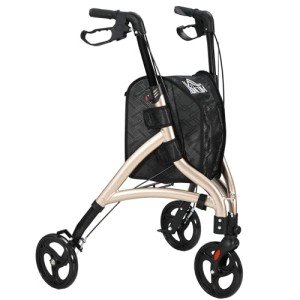rollator-walker0158
rollator-walker0158
12 Rollator Walker Facts To Bring You Up To Speed The Water Cooler
Rollator Walker Safety: A Comprehensive Guide
As people age or face mobility difficulties due to health problem or injury, maintaining independence frequently ends up being a concern. Rollator walkers, offering both assistance and mobility, have become vital tools for numerous. However, while they use many benefits, ensuring safety while using a rollator walker is paramount. This article supplies comprehensive insights into Rollator Walker Safety (Https://Seamansjobsite.Marinerslink.Com/Employer/Best-Rollator-Walker), consisting of best practices, common dangers, and essential tips for users and caretakers.
Understanding Rollators
A rollator walker is a mobility device with wheels that permits people to stroll with the support of a frame. Unlike standard walkers, rollators typically feature:
- Three or 4 wheels for simpler maneuverability
- Hand brakes for stopping and managing speed
- A seat for resting when needed
- Storage compartments for carrying individual products
These functions make rollators appropriate for both indoor and outdoor use, enhancing the lifestyle for users by providing a sense of self-reliance.
Benefits of Using Rollator Walkers
- Increased Mobility: Rollators can help users in moving around securely and easily.
- Support and Stability: With a sturdy frame and brakes, they offer essential assistance when standing or walking.
- Convenience: Many rollators included padded seats, enabling users to rest as required.
- Convenience: Integrated storage solutions can carry important products, releasing hands for much better balance.
Common Hazards Associated with Rollator Walkers
While rollators can enhance mobility and safety, they can also posture threats. Users need to know prospective risks to lessen mishaps:
- Uneven Surfaces: Rollators may tip over if used on uneven or sloped terrain.
- Braking Issues: Failing to engage the brakes effectively can cause falls.
- Excess Weight: Overloading the storage compartments can impact stability.
- Incorrect Use: Not using the rollator as intended can lead to accidents.
- Poor Maintenance: Neglecting regular look at wheels and brakes might cause failure throughout use.
Rollator Walker Safety Tips
To boost safety while utilizing rollator walkers, consider the following pointers:
1. Proper Fit and Adjustment
- Height Adjustment: Ensure that the deal with height is set to the user’s wrist level when standing upright. A correct fit motivates much better posture and control.
- Seat Height: If the rollator has a seat, guarantee it’s comfy and accessible for resting.
2. Regular Maintenance
- Examine Brakes: Make sure hand brakes are working appropriately. Adjust or change them if required.
- Inspect Wheels: Regularly examine wheels for wear and tear, and ensure they spin easily.
- Take a look at Frame: Check for loose screws or fractures in the frame to ensure it remains sturdy.
| Maintenance Task | Frequency |
|---|---|
| Brake inspect | Weekly |
| Wheel evaluation | Monthly |
| Frame evaluation | Monthly |
3. Environment Awareness
- Clear Pathways: Keep living areas free from mess and obstacles that might pose a tripping hazard.
- Lighting: Ensure that areas are well-lit to prevent bad moves, particularly during evening hours.
- Prevent Slippery Floors: Be cautious on wet or waxed floorings, as they can result in falls.
4. Safe Walking Techniques
- Engage Brakes When Stopping: Always engage brakes before sitting or while resting.
- Use Proper Walking Technique: Move gradually and maintain a steady pace, taking steps that match the rollator’s width.
- Balance While Turning: Turn thoroughly, using the rollator for support as needed.
5. Look for Assistance
- Involve Caregivers: Encourage member of the family or caretakers to assist in navigating tough terrains or circumstances.
- Benefit From Community Resources: Many communities use mobility training for those utilizing walk-assisting gadgets.
FAQs about Rollator Walker Safety
Q1: How do I select the best rollator walker?
When picking a rollator, think about the user’s weight, height, and meant use. It’s also vital to examine for features such as hand brake effectiveness and wheel size, which can impact maneuverability.
Q2: Can I use a rollator walker on unequal surfaces?
While rollators can manage a variety of terrains, it is best to avoid high inclines, gravel, or cobblestones, as these can be harmful. Adhere to flat, smooth surfaces whenever possible.
Q3: How can I avoid falls while utilizing a rollator?
Engaging the brakes when sitting, keeping paths clear, adjusting your rollator for the proper height, and bearing in mind your environments can greatly lower the danger of falls.
Q4: Are all rollator walkers the exact same?
No, rollators come in different types and sizes, developed for various requirements. Some may have additional accessories like baskets, while others are lightweight or feature a greater weight capability.
Q5: Is it safe to carry bags on a rollator?
Constantly bear in mind the weight limitation and distribution of the load. Use the rollator’s designated storage options and prevent overwhelming it.
Rollator walkers are vital gadgets that boost mobility and promote self-reliance for users dealing with mobility obstacles. Nevertheless, ensuring safety while using these gadgets is important. By comprehending prospective threats, sticking to safe practices, and keeping the walker regularly, users can delight in the benefits of their rollator with decreased threat. Ultimately, the objective is to facilitate confidence and stability, allowing individuals to navigate their world with security and ease. As care companies, relative, and neighborhoods focus on safety, they empower users towards a much better, more independent quality of life.




